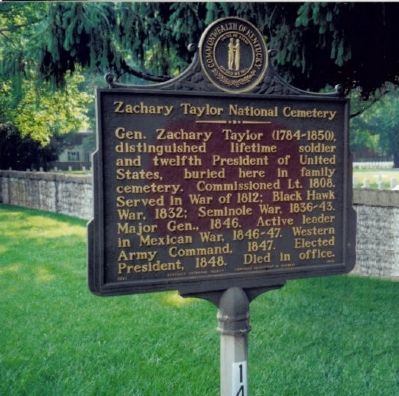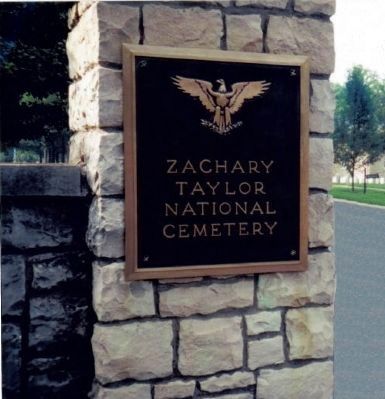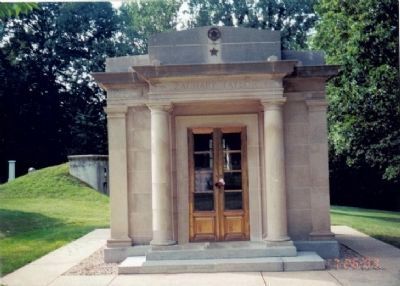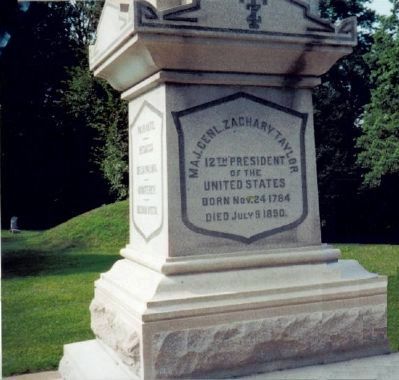Louisville in Jefferson County, Kentucky — The American South (East South Central)
Zachary Taylor National Cemetery
Erected by Commonwealth of Kentucky. (Marker Number 1412.)
Topics and series. This historical marker is listed in these topic lists: Cemeteries & Burial Sites • War of 1812 • War, Mexican-American. In addition, it is included in the Former U.S. Presidents: #12 Zachary Taylor, the Kentucky Historical Society, and the National Cemeteries series lists. A significant historical year for this entry is 1808.
Location. 38° 16.584′ N, 85° 38.497′ W. Marker is in Louisville, Kentucky, in Jefferson County. Marker is on Brownsboro Road (U.S. 42), on the right when traveling west. Touch for map. Marker is at or near this postal address: 4701 Brownsboro Road, Louisville KY 40207, United States of America. Touch for directions.
Other nearby markers. At least 8 other markers are within walking distance of this marker. Address by President Lincoln (within shouting distance of this marker); World War II 75th Division Memorial (within shouting distance of this marker); U.S.S. Canberra CA-70 (within shouting distance of this marker); First Marine Division Memorial (within shouting distance of this marker); Col. Richard Taylor (1744-1829)/George Rudy (1744-1806) (approx. ¼ mile away); Locust Grove (approx. ¼ mile away); Zachary Taylor Home (approx. 0.4 miles away); a different marker also named Zachary Taylor Home (approx. 0.4 miles away). Touch for a list and map of all markers in Louisville.
Also see . . . Official Web Site - - U. S. Dept. of Veterans Affairs. Has an excellent History of the "Zachary Taylor National Cemetery" and other items. (Submitted on August 8, 2009, by Al Wolf of Veedersburg, Indiana.)
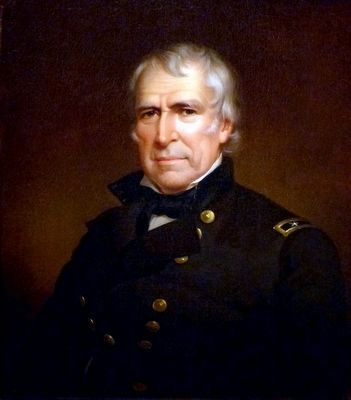
Photographed By Allen C. Browne, August 9, 2015
5. Zachary Taylor
This 1848 portrait of Zachary Taylor by James Reid Lambdin hangs in the National Portrait Gallery in Washington, DC.
“Throughout his career as a professional soldier Zachary Taylor took no more than a passing, interest in politics. But his victories at the battles of Palo Alto, Monterrey, and Buena Vista during the Mexican War changed all of that. In their wake, this ‘rough and ready’ general became eminently ripe for elective office. Even if Taylor had wanted to, he perhaps could not have stopped the groundswell of determination within the Whig Party to elect him president in 1848.
Upon entering the White House, Taylor declared his intention to bring harmony to the Union. Yet his refusal to placate the South by allowing slavery in some of the new territories acquired during the Mexican war did quite the opposite. Within a year of Taylor's coming to office, the country seemed to be moving toward civil war. Only after his unexpected death in July 1850 did compromise on this divisive issue become possible.” — National Portrait Gallery
“Throughout his career as a professional soldier Zachary Taylor took no more than a passing, interest in politics. But his victories at the battles of Palo Alto, Monterrey, and Buena Vista during the Mexican War changed all of that. In their wake, this ‘rough and ready’ general became eminently ripe for elective office. Even if Taylor had wanted to, he perhaps could not have stopped the groundswell of determination within the Whig Party to elect him president in 1848.
Upon entering the White House, Taylor declared his intention to bring harmony to the Union. Yet his refusal to placate the South by allowing slavery in some of the new territories acquired during the Mexican war did quite the opposite. Within a year of Taylor's coming to office, the country seemed to be moving toward civil war. Only after his unexpected death in July 1850 did compromise on this divisive issue become possible.” — National Portrait Gallery
Credits. This page was last revised on November 20, 2019. It was originally submitted on August 5, 2009, by Bill Coughlin of Woodland Park, New Jersey. This page has been viewed 2,884 times since then and 32 times this year. Photos: 1, 2, 3, 4. submitted on August 5, 2009, by Bill Coughlin of Woodland Park, New Jersey. 5. submitted on August 27, 2015, by Allen C. Browne of Silver Spring, Maryland.
